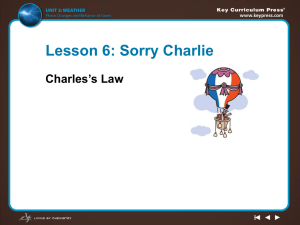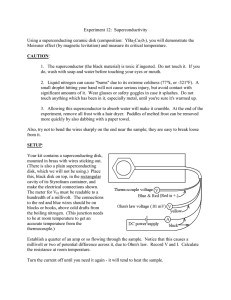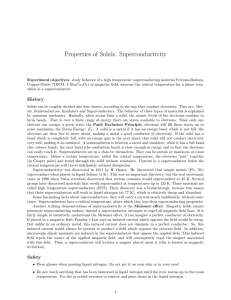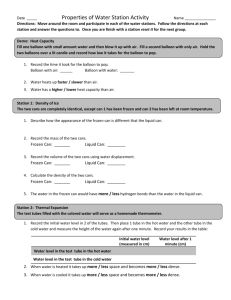Experiments with Liquid Nitrogen for High Schools
advertisement
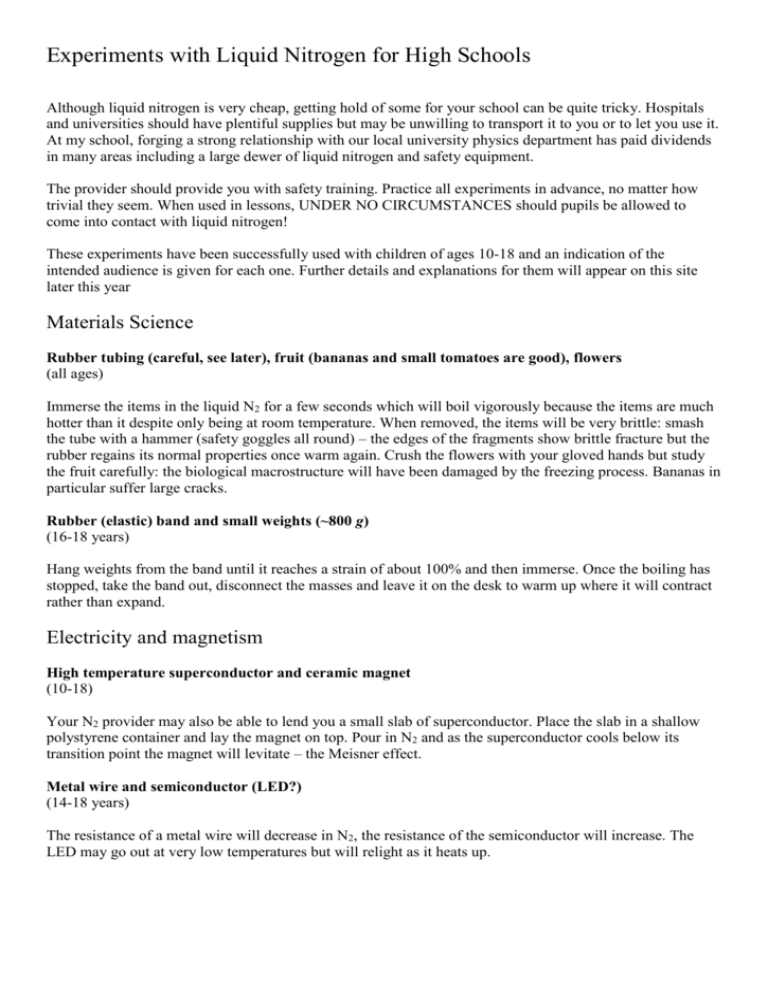
Experiments with Liquid Nitrogen for High Schools Although liquid nitrogen is very cheap, getting hold of some for your school can be quite tricky. Hospitals and universities should have plentiful supplies but may be unwilling to transport it to you or to let you use it. At my school, forging a strong relationship with our local university physics department has paid dividends in many areas including a large dewer of liquid nitrogen and safety equipment. The provider should provide you with safety training. Practice all experiments in advance, no matter how trivial they seem. When used in lessons, UNDER NO CIRCUMSTANCES should pupils be allowed to come into contact with liquid nitrogen! These experiments have been successfully used with children of ages 10-18 and an indication of the intended audience is given for each one. Further details and explanations for them will appear on this site later this year Materials Science Rubber tubing (careful, see later), fruit (bananas and small tomatoes are good), flowers (all ages) Immerse the items in the liquid N2 for a few seconds which will boil vigorously because the items are much hotter than it despite only being at room temperature. When removed, the items will be very brittle: smash the tube with a hammer (safety goggles all round) – the edges of the fragments show brittle fracture but the rubber regains its normal properties once warm again. Crush the flowers with your gloved hands but study the fruit carefully: the biological macrostructure will have been damaged by the freezing process. Bananas in particular suffer large cracks. Rubber (elastic) band and small weights (~800 g) (16-18 years) Hang weights from the band until it reaches a strain of about 100% and then immerse. Once the boiling has stopped, take the band out, disconnect the masses and leave it on the desk to warm up where it will contract rather than expand. Electricity and magnetism High temperature superconductor and ceramic magnet (10-18) Your N2 provider may also be able to lend you a small slab of superconductor. Place the slab in a shallow polystyrene container and lay the magnet on top. Pour in N2 and as the superconductor cools below its transition point the magnet will levitate – the Meisner effect. Metal wire and semiconductor (LED?) (14-18 years) The resistance of a metal wire will decrease in N2, the resistance of the semiconductor will increase. The LED may go out at very low temperatures but will relight as it heats up. Semiconductor (LED?) and low-temperature thermocouple (16-18 years) Cool the LED down. If good thermal contact between the thermocouple and the LED can be obtained then as it heats up (must be done slowly – prevent self-heating by switching off between readings) readings of current and temperature should follow the Boltzmann factor: kT I e with being of the order of a few eV. Gases and the kinetic theory Small balloon (13-18 years) Carefully and slowly, immerse the balloon in the N2. It should deflate considerably. Remove it and place it on the desk and it should slowly re-inflate (Charles’ law). This experiment can be repeated many times before the balloon perishes. Balloon and test tube (10-18) The container your N2 comes in will not have a sealed top – this experiment shows why. Fill a test tube about 70% full with N2 and then put the unfilled balloon over the end. As the N2 evaporates it will inflate the balloon because 1 cm3 of liquid N2 becomes about 700 cm3 of gas. TT ball with hole in or Hero’s engine (10-18) As the liquid boils the gas will escape out of the holes and spin the ball or engine. Getting the N2 inside the apparatus is tricky and should be done slowly in advance. Hosepipe - CAREFUL (10-18) Place one end of a 40 cm length of hollow rubber tube into the N2. The other end MUST be pointing somewhere safe as N2 will spurt out of it. The end in the N2 causes boiling and expansion which forces liquid N2 up the tube. When it lands on the floor it evaporates spectacularly WARNING: on solid floor surfaces, beads of liquid will race downhill across the floor. Solid floor in an empty lab (10-18) Pour liquid N2 across the floor. Any dust will be picked up by the liquid and taken to the edge of the room. The N2 then evaporates leaving a dry floor. The N2 will flow downhill so be careful. ALL THESE EXPERIMENTS ARE DANGEROUS AND SOME ARE MORE DANGEROUS THAN OTHERS. CERN ACCEPTS NO RESPONSIBILITY – TEACHERS PERFORM THEM AT THEIR OWN RISK.






